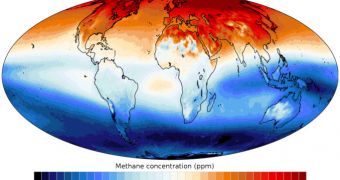Most of you have heard by now about the damages that carbon dioxide can produce in our planet's upper atmosphere. But this particular chemical is getting so much attention not because it's the most dangerous of all greenhouse gases, but simply because massive amounts of it are emitted into the air each year. There are numerous other substances that exceed its “performances,” the most notable of which is methane, with a heat absorption capability 200 times more efficient than that of CO2.
These so-called trace gases can be found in very small concentrations in the planet's atmosphere, but researchers at the NASA Ames Research Center, in Moffett Field, California, say that it is one of their goals to keep an eye on their evolution. If these chemicals are overlooked, and then allowed to multiply in the atmosphere, then, by the time we figure it all out, it may be too late to do anything about it. In addition to methane, the team says, gases containing fluorine atoms, such as hydrofluorocarbons (HFC), chlorofluorocarbons (CFC), and perfluorocarbons, are also devastating to the environment.
Unlike methane, which only endures in the air for an average time of 12 years, the other gases have a lifetime of several millennia, which makes studying them an even more important priority for climate scientists. “To protect Earth’s climate, we need to understand the molecular properties that determine heat absorption, and design molecules that are more environmentally friendly. Our [new] paper is the first to focus on the inherent capabilities of molecules to absorb Earth’s radiated heat,” explains Ames astrochemist Timothy Lee, who was a member of the science team behind the new investigation.
“The paper does not address toxicity, atmospheric lifetime, nor the atmospheric fate of molecules. Rather, we argue that radiative efficiency is another fundamental property that should be considered in addition to these other properties,” adds Ames postdoctoral fellow Partha Bera. The expert contributed as first author of two scientific papers related to this subject. The first one appeared in the Journal of Physical Chemistry A, in 2009, and the second one was recently published, in the latest issue of the esteemed journal Proceedings of the National Academy of Sciences (PNAS), Space Fellowship reports.
“The paper is important because it suggests that a researcher can get a first estimate of the radiative property of a molecule just by knowing the combination of atoms in the molecule,” explains Purdue University professor of Earth and atmospheric sciences, and of chemistry, Joseph Francisco. He participated as a coauthor in both investigations. “Every molecule has a unique vibrational pattern, which is determined by the bond between atoms. These vibrating bonds are where heat is absorbed and retained,” Bera concludes.

 14 DAY TRIAL //
14 DAY TRIAL //